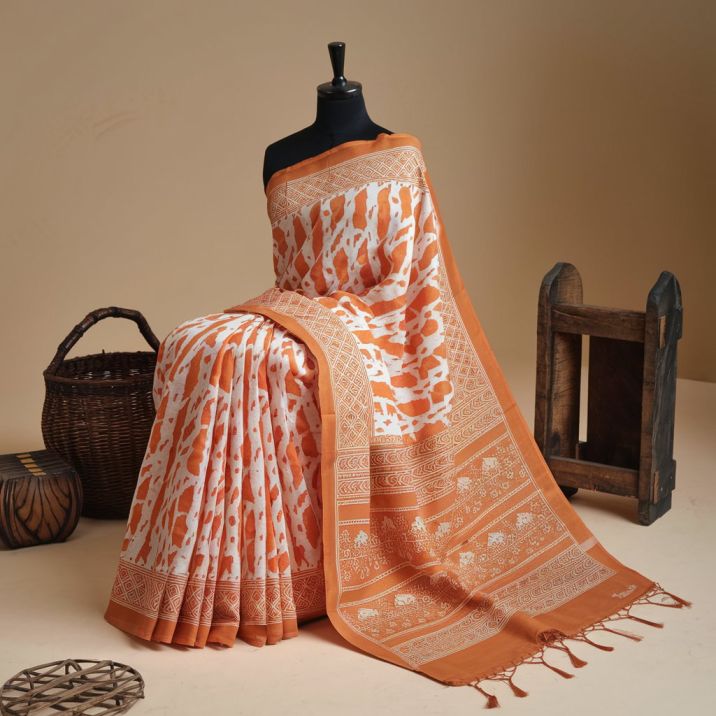Quick Guide: Caring for Your Sambalpuri Sarees
Sambalpuri sarees, exquisite handwoven treasures from Odisha, are celebrated for their intricate designs, vibrant hues, and profound cultural significance. These timeless garments often hold sentimental value, passed down through generations as heirlooms. It is essential to care for them meticulously to maintain their unmatched beauty and longevity.
Bunkar Valley, the online store for authentic Odisha handloom, is committed to guiding you through preserving these masterpieces. This detailed guide provides you with all the necessary tips and techniques to care for your precious Sambalpuri sarees, ensuring they remain as stunning as the day you acquired them.
Understanding the Fabric and Weave
Identify the Fabric
The fabric of your Sambalpuri saree determines the appropriate care routine:
- Silk Sarees: Silk sarees are now known for their luxurious feel. They are delicate and require gentle handling. The protein fibers in silk are vulnerable to harsh chemicals and rough treatment. We recommend professional dry cleaning. If handwashing is necessary, use cold water and a mild, pH-neutral detergent designed for silk.
- Cotton Sarees: Handwash cotton sarees in cold or lukewarm water with a mild detergent. They are durable yet prone to shrinking and color bleeding. Avoid harsh scrubbing or wringing to maintain their integrity.
- Tussar Sarees: Tussar silk is more durable than mulberry silk due to its unique, coarse texture and natural golden sheen. These sarees are best maintained through dry cleaning to preserve their texture and sheen. Avoid handwashing unless necessary.
The Significance of the Weave
The beauty of Sambalpuri sarees lies in their distinct weaving styles:
- Bomkai: Bomkai sarees are known for their intricate thread work, which combines ikat and embroidery. They require careful handling to protect delicate embellishments.
- Pasapalli: The weavers create these sarees using silk and cotton, creating a characteristic checkerboard pattern. While they are durable, one must not snag the threads.
- Ikat: The hallmark of Sambalpuri sarees, ikat involves tie-dyeing yarns before weaving, creating unique patterns. The dyeing process can cause the colors to bleed, so extra care is necessary when washing.
Understanding the fabric and weave deepens your appreciation of these sarees and enables you to tailor their care.
Washing and Cleaning Your Sambalpuri Saree
Dry Cleaning vs. Handwashing
Choose the cleaning method based on the fabric:
- Silk and Tussar Sarees: Opt for professional dry cleaning to prevent shrinkage, color fading, and damage to delicate fibers.
- Cotton Sarees: Handwashing is often suitable, provided you follow these steps:
- Test for Colorfastness: Dab a wet cotton ball on a small, hidden area to see if the colors bleed.
- Use Cold Water: Wash in cold water to prevent shrinking and color bleeding.
- Mild Detergent: Use pH-neutral detergents designed for delicate fabrics. Avoid bleach or harsh chemicals.
- Gentle Handling: Avoid scrubbing or wringing. Gently agitate the saree and soak it for no more than 10 minutes.
- Thorough Rinsing: Rinse the saree in cold water until you remove all detergent.
- Drying: Roll the saree in a clean towel to absorb excess water, then air-dry it in a shaded area to prevent color fading.
Tips to Remove Stain
Stains on your Sambalpuri saree need immediate attention:
- Water-Based Stains: Rinse with cold water and use a mild detergent solution.
- Oil-Based Stains: Use cornflour or talcum powder to absorb the oil. Brush it off gently after a few hours.
- Protein-Based Stains: Soak in cold water and gently rub with mild detergent. Avoid hot water, as it might set the stain.
- Stubborn Stains: For persistent stains, seek professional dry cleaning assistance.
How to Store and Maintain Your Sambalpuri Saree?
Proper Folding and Storage Tips
Proper Correct storage is crucial for longevity:
- Air Out Before Storing: Let the saree breathe for a few hours before storing to remove moisture or odors.
- Avoid Plastic Bags: Use breathable cotton saree bags or wrap them in a muslin cloth to prevent mildew.
- Acid-Free Paper: Line storage boxes with acid-free paper to prevent discoloration.
- Cool, Dry Place: Store sarees in a dark and dry place strictly away from direct sunlight and heat.
- Periodic Refolding: Refold sarees along different lines every few months to avoid permanent creases.
- Pest Prevention: Place dried neem leaves or naphthalene balls near storage areas, ensuring they do not touch the fabric.
Ironing and Finishing Touches
Ironing can refresh your saree, but you need to be careful while doing it:
- Fabric-Specific Settings: Set a low heat setting when wearing silk and tussar sarees. Cotton sarees can withstand slightly higher temperatures.
- Pressing Cloth: Place a cotton cloth between the saree and the iron to prevent scorching.
- Reverse Side Ironing: Iron on the reverse side to protect embellishments and zari work.
- Steam Iron: Use steam to remove creases gently.
- Avoid Direct Ironing on Zari: Iron around Zari work or use a pressing cloth.
Reviving and Recycling Old Sambalpuri Sarees
Revive Your Old Sarees
When a saree becomes unwearable, its journey can continue through upcycling:
- Transform Garments: Convert old sarees into kurtas, dupattas, skirts, or dresses.
- Home Decor: Use saree fabric to craft cushion covers, table runners, or wall hangings.
- Accessories: Create potlis, scarves, or jewelry from smaller fabric pieces.
- Quilting: Combine pieces from different sarees to make a unique quilt.
Repair and Restore
Preserve damaged sarees with skilled repairs:
- Darning: Fix small holes using matching threads.
- Patchwork: Cover larger tears with fabric patches.
- Embroidery: Add decorative stitching to conceal imperfections.
- Professional Restoration: Consult experts specializing in restoring handwoven sarees for significant damage.
Caring for your Sambalpuri saree goes beyond maintenance; it is about preserving a rich traditional heritage and artistic legacy. By following these guidelines, you can ensure that your cherished sarees remain a testament to timeless craftsmanship. Bunkar Valley takes pride in offering the finest handloom sarees and the knowledge to care for them. Explore our exquisite collection and celebrate the elegance of Sambalpuri sarees.


